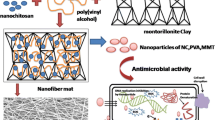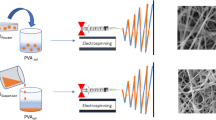Abstract
The present study provides credence to the formation of polyvinyl alcohol (PVA)–Azadirachta indica (neem) nanofibrous mat (PNNM) under optimum processing conditions of electrospinning technique from a mixer of PVA and neem extract to utilize the inherent medicinal properties of this herb for biomedical application. The bonding behavior, orientation of fibers, thermal behavior, and moisture management properties were evaluated by Fourier transforms infrared spectroscopy (FTIR), scanning electron microscopy (SEM), thermo gravimetric analysis (TGA) and moisture management tester (MMT) reports respectively. The antibacterial activity of the developed sample at the maximum mixing ratio of neem extract (80%) was tested against Gram-positive (S. aureus) bacteria using agar disc diffusion method. The results reveal that the prepared nanofibrous mat exhibited better thermal and moisture management properties in comparison with PVA nanofiber alone. The formation of smooth fibers was confirmed by SEM images having average diameter of 185 nm under 5k, 10k and 15k magnifications. The characteristic peaks of PVA and neem constituents in FTIR spectra of the developed mat confirmed the presence of both components. Bacterial resistance was reached up to 20 mm due to the antibacterial constituents of neem extract. Thus the developed mat could be used as a biocompatible and bio based in biomedical applications.
Graphic Abstract







Similar content being viewed by others
References
Guarino V, Ambrosio L (2018) Electrofluidodynamic technologies (EFDTs) for biomaterials and medical devices: principles and advances. Woodhead Publishing, Sawston
Ramakrishna S (2005) An introduction to electrospinning and nanofibers. World Scientific, Singapore
Huang Z-X, Wu J-W, Wong S-C, Qu J-P, Srivatsan T (2018) The technique of electrospinning for manufacturing core–shell nanofibers. Mater Manuf Processes 33(2):202–219
Abdullah N, Sekak KA, Ahmad M, Effendi TB (eds) (2014) Characteristics of electrospun PVA-Aloe vera nanofibres produced via electrospinning. Proceedings of the International Colloquium in Textile Engineering, Fashion, Apparel and Design 2014 (ICTEFAD 2014). Springer
Agarwal S, Wendorff JH, Greiner A (2008) Use of electrospinning technique for biomedical applications. Polymer 49(26):5603–5621
Bhardwaj N, Kundu SC (2010) Electrospinning: a fascinating fiber fabrication technique. Biotechnol Adv 28(3):325–347
Lannutti J, Reneker D, Ma T, Tomasko D, Farson D (2007) Electrospinning for tissue engineering scaffolds. Mater Sci Eng C 27(3):504–509
Barhate R, Loong CK, Ramakrishna S (2006) Preparation and characterization of nanofibrous filtering media. J Membr Sci 283(1–2):209–218
Venugopal JR, Low S, Choon AT, Kumar AB, Ramakrishna S (2008) Nanobioengineered electrospun mat nanofibers and osteoblasts for bone regeneration. Artif Organs 32(5):388–397
Wang X, Ding B, Li B (2013) Biomimetic electrospun nanofibrous structures for tissue engineering. Mater Today 16(6):229–241
Zhan Y, Zhao R, Xiang X, He S, Zhao S, Xue W (2019) Hierarchical core/shell bamboo-like polypyrrole nanofibers/Fe3O4 hybrids with superior microwave absorption performance. Mat Interfaces. 26:1–14
Bhattarai SR, Bhattarai N, Yi HK, Hwang PH, Cha DI, Kim HY (2004) Novel biodegradable electrospun membrane: scaffold for tissue engineering. Biomaterials 25(13):2595–2602
Lee KY, Jeong L, Kang YO, Lee SJ, Park WH (2009) Electrospinning of polysaccharides for regenerative medicine. Adv Drug Deliv Rev 61(12):1020–1032
Sridhar R, Lakshminarayanan R, Madhaiyan K, Barathi VA, Lim KHC, Ramakrishna S (2015) Electrosprayed nanoparticles and electrospun nanofibers based on natural materials: applications in tissue regeneration, drug delivery and pharmaceuticals. Chem Soc Rev 44(3):790–814
Vasita R, Katti DS (2006) Nanofibers and their applications in tissue engineering. Int J Nanomed 1(1):15
Zahedi P, Rezaeian I, Ranaei-Siadat SO, Jafari SH, Supaphol P (2010) A review on wound dressings with an emphasis on electrospun nanofibrous polymeric bandages. Polym Adv Technol 21(2):77–95
Fayemi OE, Ekennia AC, Katata-Seru L, Ebokaiwe AP, Ijomone OM, Onwudiwe DC et al (2018) Antimicrobial and wound healing properties of polyacrylonitrile-moringa extract nanofibers. ACS Omega 3(5):4791–4797
Avci H, Monticello R, Kotek R (2013) Preparation of antibacterial PVA and PEO nanofibers containing Lawsonia Inermis (henna) leaf extracts. J Biomater Sci Polym Ed 24(16):1815–1830
Mahendran R, Sridharan D, Arunmozhidevan C, Selvakumar T, Rajasekar P (2016) Fabrication and antibacterial effects of polycarbonate/leaf extract based thin films. J Mater. https://doi.org/10.1155/2016/3194154
Sridhar R, Ravanan S, Venugopal JR, Sundarrajan S, Pliszka D, Sivasubramanian S et al (2014) Curcumin-and natural extract-loaded nanofibres for potential treatment of lung and breast cancer: in vitro efficacy evaluation. J Biomater Sci Polym Ed 25(10):985–998
Chinchillas-Chinchillas MJ et al (2019) Synthesis of recycled poly (ethylene terephthalate)/polyacrylonitrile/styrene composite nanofibers by electrospinning and their mechanical properties evaluation. J Polym Environ 27(3):659–669
Kawano A et al (2019) Preparation of chitin nanofiber-reinforced xanthan gum hydrogels. J Polym Environ 27(4):671–677
Kummer G et al (2018) Development of nanofibers composed of chitosan/nylon 6 and tannin/nylon 6 for effective adsorption of Cr(VI). J Polym Environ 26(10):4073–4084
Mokhtari-Shourijeh Z, Montazerghaem L, Olya M (2018) Preparation of porous nanofibers from electrospun polyacrylonitrile/polyvinylidene fluoride composite nanofibers by inexpensive salt using for dye adsorption. J Polym Environ 26:3550–3563
Pereao O et al (2019) Morphology, modification and characterisation of electrospun polymer nanofiber adsorbent material used in metal ion removal. J Polym Environ 27:1–18
Sargazi G et al (2018) Synthesis of CS/PVA biodegradable composite nanofibers as a microporous material with well controllable procedure through electrospinning. J Polym Environ 26(5):1804–1817
Sato K, Yamamoto K, Kadokawa J-I (2018) Preparation of cationic/anionic chitin nanofiber composite materials. J Polym Environ 26(9):3540–3549
Shekh MI, Patel KP, Patel RM (2018) Electrospun ZnO nanoparticles doped core-sheath nanofibers: characterization and antimicrobial properties. J Polym Environ 26(12):4376–4387
Salam R, Khokon J, Mussa SBM (2014) Effect of neem and betel leaf against oral bacteria. Int J Nat Soc Sci 1:52–57
Subapriya R, Nagini S (2005) Medicinal properties of neem leaves: a review. Curr Med Chem 5(2):149–156
Atal CK, Kapur B (1982) Cultivation and utilization of medicinal plants. University of Michigan, Ann Arbor
Devakumar C, Dev S, Randhawa N, Parmar B (1993) Neem research and development. Society of Pesticide Science, Delhi
Randhawa N, Parmar B (1993) Neem: research and development. Neem: research and development
Tesso H, Nisha A, Kumsa K (2015) Antibacterial activity and phytochemical screening of some important medicinal plants against human diarrheal pathogens in Adama city, Ethiopia. Int J Microbiol Immunol Res 3(3):029–035
Vijayaram S, Kannan S, Saravanan KM, Vasantharaj S, Sathiyavimal S, Palanisamy SP (2016) Preliminary phytochemical screening, Antibacterial potential and GCMS analysis of two medicinal plant extracts. Pak J Pharm Sci 29(3):819–822
Chattopadhyay D, Chawla-Sarkar M, Chatterjee T, Dey RS, Bag P, Chakraborti S et al (2009) Recent advancements for the evaluation of anti-viral activities of natural products. New Biotechnol 25(5):347–368
Dhakal S, Aryal P, Aryal S, Bashyal D, Khadka D (2016) Phytochemical and antioxidant studies of methanol and chloroform extract from leaves of Azadirachta indica A. Juss in Tropical region of Nepal. J Pharm Phytother. 8(12):203–208
Nayak A, Nayak R, Soumya B, Bhat K, Kudalkar M (2011) Evaluation of antibacterial and anticandidial efficacy of aqueous and alcoholic extract of Neem (Azadirachta indica) an in vitro study. Int J Res Ayurveda Pharm 2:230–235
Neeta P, Pankaj M (2016) Antibacterial study of neem patra extracts on Escherichia coli, Pseudomonas aeuroginosa, Corynebacteria, Staphylococcus aureus and Staphylococcus epidermidis—AN in vitro study. International Journal Of Ayurvedic And Herbal Medicine. 6(3):2248–2251
Priadarshini A, Pankaj PP, Varma M, Kumar K (2013) Evaluation of the antibacterial potential of Moringa oleifera and Azadirachta indica against some pathogenic microbes: a comparative study. Int J Drug Dev Res 5(1):214–218
Amin A (2011) In vitro bactericidal and bacteriostatic potential of ingredients of traditional medicine obtained from Kacha area (River Indus) district DI Khan, KPK, against human bacterial pathogens. Pak J Bot 43(5):26137
Azmir J, Zaidul I, Rahman M, Sharif K, Mohamed A, Sahena F et al (2013) Techniques for extraction of bioactive compounds from plant materials: a review. J Food Eng 117(4):426–436
Lall WS, Charan AA, Bind A (2013) Antimicrobial activity of methanolic and acetonic extracts of Azadirachta indica, Saraca asoca and Curcuma longa. Int J Med Pharm Sci 3(2):79–86
Tirumalasetty J, Anuradha B, Praveena A (2014) Antimicrobial activity of methanolic extracts of Azadirachta indica, Rosmarinus officinalis and Lagenaria siceraria leaves on some important pathogenic organisms. J Chem Pharm Res 6:766–770
Asif M (2012) Antimicrobial potential of Azadirachta indica against pathogenic bacteria and fungi. J Pharmacogn Phytochem. 1(4):78–83
Chundran NK, Husen IR, Rubianti I (2015) Effect of neem leaves extract (Azadirachta indica) on wound healing. Althea Med J 2(2):199–203
Saradhajyothi K, Subbarao B (2011) Antibacterial potential of the extracts of the leaves of Azadirachta indica Linn. Notulae Scientia Biologicae 3(1):65–69
Bonan RF, Bonan PR, Batista AU, Sampaio FC, Albuquerque AJ, Moraes MC et al (2015) In vitro antimicrobial activity of solution blow spun poly (lactic acid)/polyvinylpyrrolidone nanofibers loaded with Copaiba (Copaifera sp.) oil. Mater Sci Eng C 48:372–377
Jaganathan SK, Mani MP, Palaniappan SK, Rathanasamy R (2018) Fabrication and characterisation of nanofibrous polyurethane scaffold incorporated with corn and neem oil using single stage electrospinning technique for bone tissue engineering applications. J Polym Res 25(7):146
Jaganathan SK, Mani MP, Rathanasamy R, Prabhakaran P (2018) Fabrication and characterization of tailor-made novel electrospun fibrous polyurethane scaffolds decorated with propolis and neem oil for tissue engineering applications. J Ind Text. https://doi.org/10.1177/1528083718808787
Mani MP, Jaganathan SK, Khudzari AZ, Rathanasamy R, Prabhakaran P (2018) Single-stage electrospun innovative combination of polyurethane and neem oil: synthesis, characterization and appraisal of blood compatibility. J Bioact Compat Polym 33(6):573–584
Mráz J, Nohová H (1992) Percutaneous absorption of N,N-dimethylformamide in humans. Int Arch Occup Environ Health 64(2):79–83
Kim TH, Kim SG (2011) Clinical outcomes of occupational exposure to n, n-dimethylformamide: perspectives from experimental toxicology. Safety Health Work 2(2):97–104
Joshi DR, Adhikari N (2019) An overview on common organic solvents and their toxicity. J Pharm Res Int. https://doi.org/10.9734/jpri/2019/v28i330203
Massmann W (1956) Toxicological investigations on dimethylformamide. Br J Ind Med 13(1):51
Galya T, Sedlařík V, Kuřitka I, Novotný R, Sedlaříková J, Sáha P (2008) Antibacterial poly (vinyl alcohol) film containing silver nanoparticles: preparation and characterization. J Appl Polym Sci 110(5):3178–3185
Gao Q, Luo J, Wang X, Gao C, Ge M (2015) Novel hollow α-Fe2O3 nanofibers via electrospinning for dye adsorption. Nanoscale Res Lett 10(1):176
Ali A, Shahid MA, Hossain MD, Islam MN (2019) Antibacterial bi-layered polyvinyl alcohol (PVA)-chitosan blend nanofibrous mat loaded with Azadirachta indica (neem) extract. Int J Biol Macromol 138:13–20
Unnithan AR, Barakat NA, Pichiah PT, Gnanasekaran G, Nirmala R, Cha Y-S et al (2012) Wound-dressing materials with antibacterial activity from electrospun polyurethane–dextran nanofiber mats containing ciprofloxacin HCl. Carbohyd Polym 90(4):1786–1793
Dev VG, Venugopal J, Sudha S, Deepika G, Ramakrishna S (2009) Dyeing and antimicrobial characteristics of chitosan treated wool fabrics with henna dye. Carbohyd Polym 75(4):646–650
Rashidi S, Ataie A (2016) Structural and magnetic characteristics of PVA/CoFe2O4 nano-mats prepared via mechanical alloying method. Mater Res Bull 80:321–328
Acknowledgements
Department of Textile Engineering and Institute of Energy Engineering (IEE), DUET, Gazipur, Bangladesh is thankfully acknowledged. Sincere gratitude due to Waffen Research Laboratory (WRL), Dhaka for their unfailing support during the study.
Funding
No financial support has been received.
Author information
Authors and Affiliations
Corresponding author
Ethics declarations
Conflict of interest
On behalf of all authors, the corresponding author declares that there is no conflict of interest.
Additional information
Publisher's Note
Springer Nature remains neutral with regard to jurisdictional claims in published maps and institutional affiliations.
Rights and permissions
About this article
Cite this article
Ali, A., Shahid, M.A. Polyvinyl Alcohol (PVA)–Azadirachta indica (Neem) Nanofibrous Mat for Biomedical Application: Formation and Characterization. J Polym Environ 27, 2933–2942 (2019). https://doi.org/10.1007/s10924-019-01587-9
Published:
Issue Date:
DOI: https://doi.org/10.1007/s10924-019-01587-9




